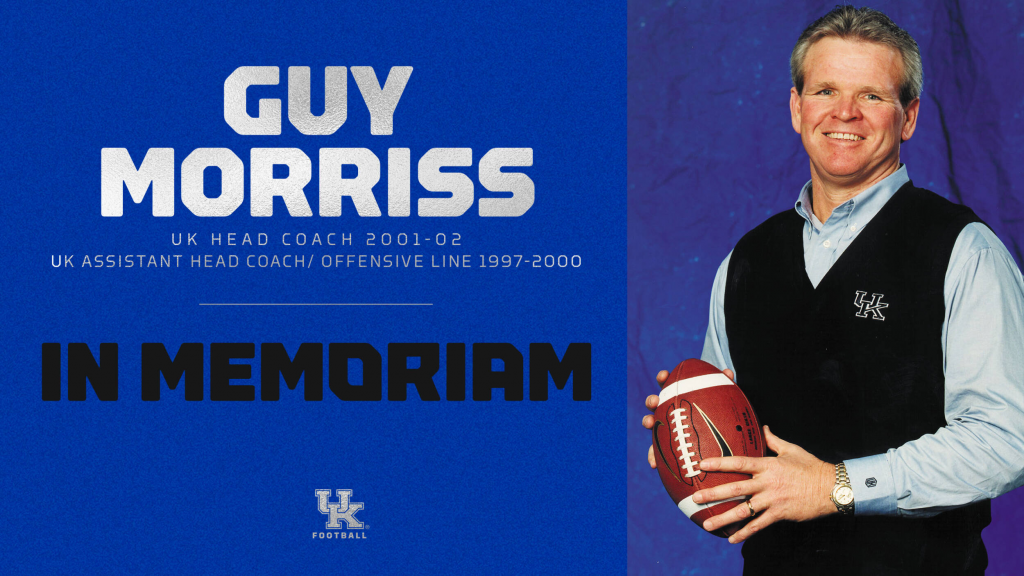
LONGTIME NFL OFFENSIVE LINEMAN WAS AN EVERYMAN, AND A GOOD MAN, TOO
He was a decent man, an earnest man. He believed in hard work, and made football his life’s work.
Guy Morriss could have turned bitter, after Alzheimer’s disease began to take its toll six or seven years ago. He spent two years as the head coach at the University of Kentucky, after Hal Mumme’s abrupt departure from the school awaiting severe NCAA sanctions in 2002.
He logged 15 years as an NFL player, an offensive lineman with the Philadelphia Eagles and New England Patriots. He was a native Texan who loved football, but he lived his final years in Danville, Kentucky, just a 30- or 45-minute drive from the UK campus.
Mr. Morriss died on Tuesday at the age of 71. Simply put, he was a good man.
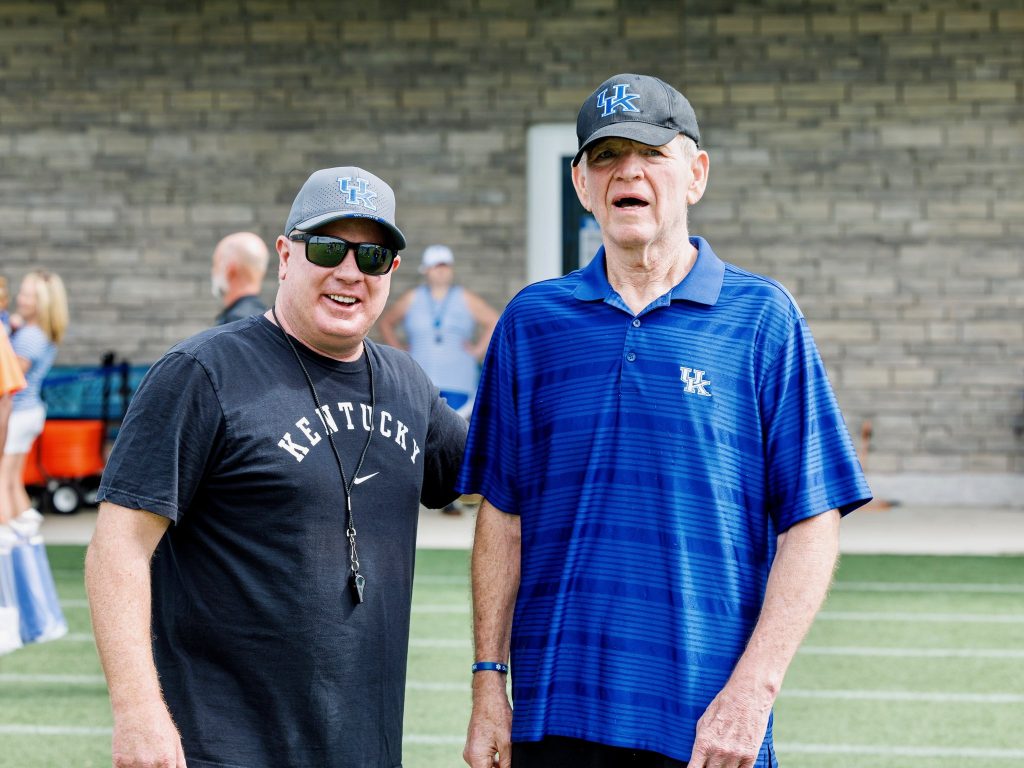
WITH AN AILING GUY MORRISS EARLIER THIS YEAR.
UK coach Mark Stoops expressed his condolences via Twitter, appreciative of what Morriss meant to the Wildcats, their fans, and college football.
Stoops’ statement read:
“I’m so saddened to hear of the passing of Coach Morriss. I’m grateful for everything he did for this program. We loved seeing him around here and just a few short weeks ago he attended Fan Day. Our thoughts and prayers are with (wife) Jackie and his family.”
Morriss had his moments of success, as a player and a coach, but his coaching record as a college head coach (27-54 in a combined seven years at Kentucky and Baylor University) tells only part of his story.
The most significant part was how he touched lives, how he inspired others, how he lived his life.
Guy Morriss was on the sideline when LSU pulled off the “Bluegrass Miracle” at Commonwealth Stadium, when the Wildcats prematurely celebrated on the sideline on November 9, 2002. He was in his second year as the Wildcats’ head coach, taking over under difficult circumstances, when previous coach Hal Mumme slipped out of town with NCAA penalties looming over the school.
That was his last season in Lexington, as he returned to his native Texas to coach the Baylor Bears.
Baylor went 8-40 in those five seasons Morriss was calling the shots in Waco, including a dismal 7-33 record in Big 12 play. He had plenty of money, for retirement, and you couldn’t have blamed him if he’d just stopped to smell the roses, taken Jackie and his family to Europe and the Caribbean, and rested his ailing bones.
Needless to say, that wasn’t Guy Morriss’ style.
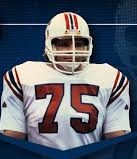
WITH THE NFL’S NEW ENGLAND PATRIOTS.
As I mentioned, Morriss spent 15 years in the NFL. As an offensive lineman. He was the New England Patriots’ starting center during the 1985-86 season, when they made an improbable run to Super Bowl XX, before becoming a footnote to the Bears’ only Super Bowl championship season.
In 2009, after his five-year Baylor stint, Morriss took over at NCAA Division II Texas A&M-Commerce, formerly East Texas State University.
He stuggled there, too. But he showed up every day, he went to work and worked his hind quarters off, and he wouldn’t express any semblance of bitterness for how it all ended. The tough times seemed to just make him a little tougher.
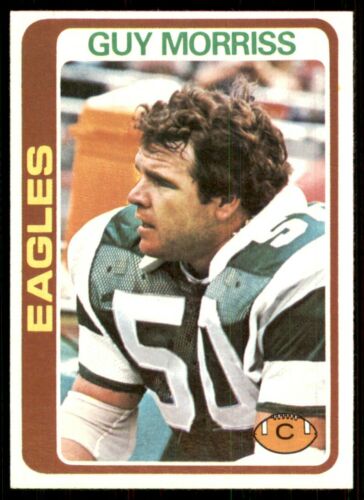
Morriss was the offensive line coach at Mississippi State University in 1996, a one-year run on Jackie Sherrill’s MSU staff before moving on to join Mumme at Kentucky. Morriss was the Wildcats’ offensive line coach and assistant head coach for five seasons, before Mumme’s departure.
I was covering the SEC and New Orleans Saints in those days, for the Biloxi-Gulfport newspaper, and I was fortunate enough to get to know him. He was honest, he was accommodating, and he never lost his sense of perspective.
Kentucky was Missisissippi State’s permanent SEC East opponent, in those days, on the schedule. Morriss was one of the few college coaches who would actually give out his home and/or office phone number, and he was really good about returning phone calls.
(One time, he got back to me while I was trying to check out of a Holiday Inn Express in Meridian, Mississippi, the last town on Interstate 59 in the five-hour journey, give or take, from Biloxi-Gulfport to Starkville.)
He was real. Real as it comes.
I think I talked to him a couple times while he was at Baylor, but he was fighting an uphill battle at the only private school in the fledgling Big 12 Conference. After his departure from Baylor, after the 2007 season, we lost touch. My life got pretty much turned upside down by Hurricane Katrina, in 2005, and four years after Morriss’ final season at Baylor, I was laid off by the Biloxi-Gulfport paper.
And I WAS bitter.
All of which makes me appreciate Guy Morriss a lot more.
He understood that respect was a two-way street. He wouldn’t ask for more from his coaching staff than what he was willing to do himself. He was good with the media, and the public.
Morriss was kind of an Everyman, when you think about it, and he had no problem with that. Basically, he was a good dude.
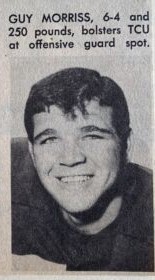
TOUTS GUY MORRISS’ EXPLOITS AT TCU IN THE 1970s.
Guy Morriss was born in Colorado City, Texas, a town of about 7,000 souls at the time, in 1951. West Texas. Off the beaten path, to be sure.
He was a high school football star, even as an offensive and defensive lineman, and was featured in “Dave Campbell’s Texas Football,” the annual summertime magazine with previews on the Lone Star State’s two NFL teams, all of its colleges and each and every high school from El Paso to Orange, from Brownsville to Lubbock.
(I was an avid reader of the magazine while learning the game at the youth level and in junior high. My Dad even picked up two or three copies of it, after my family relocated to suburban Washington, D.C., in 1970. Guy was only five years older than myself.)
Morriss played his college football at TCU, when the Horned Frogs were a perennial also-ran, at best, in the Southwest Conference. He was a second-round draft choice, of the NFL’s Philadelphia Eagles, and was a solid NFL player, logging time at center and guard for the Eagles and New England Patriots. Morriss was a proven performer in Philadelphia, reaching the Super Bowl in January, 1981 — the Eagles got waxed by Jim Plunkett and the Oakland Raiders, 27-10 — before providing valuable leadership in his four-year stint with the Patriots.

Morriss got back to the Super Bowl, in January, 1986, with the Patriots. It was the first time I ever got to cover the big game, in New Orleans. The Chicago Bears danced and shuffled their way to a resounding 46-10 victory, in the Louisiana Superdome, but men like Guy Morriss, backup quarterback Steve Grogan, future Hall of Fame linebacker Andre Tippitt and defensive end Ray “Sugar Bear” Hamilton kept playing their tails off, to the final whistle.
Toughness. That was Morriss’ calling card, toughness. And a warm, engaging personality.
You might see the “Bluegrass Miracle” on TV today, reporting Morriss’ death, a recollection of the November 9, 2002 game in Lexington, when the Wildcats fell apart when it mattered most.
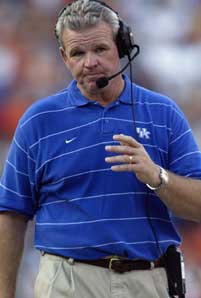
The cameras caught the late, great Jared Lorenzen and his UK teammates celebrating a seemingly impending upset of Nick Saban’s LSU Tigers, on that chilly day in Lexington. They even gave him the “bucket treatment,” pouring Gatorade down the back of the personable UK coach.
UK students had already streamed onto the field, defying the SEC edict against it, and it seemed the Wildcats were going to win 30-27.
You know what happened next.
LSU was the defending SEC champion. The Tigers were ranked 16th by the AP, 14th by the coaches. Kentucky was sporting a 6-3 record at the time, but the Wildcats were ineligible for a bowl game because of NCAA sanctions.
Even then, Kentucky football was still pretty much an afterthought until basketball season arrived. Morriss knew the game wasn’t over, and sure enough, LSU’s Marcus Randall unloaded a pass deep downfield for Michael Clayton, only to see it tipped by a UK defender.
The Tigahs’ Devery Henderson was following the flight of the ball from a few yards away, and after it was tipped into the air, he snared it at about the Wildcats’ 15-yard line on his way to the end zone. The jaw-dropping touchdown pass covered 75 yards, and immediately became LSU football lore. It was something else, obviously, at Kentucky, and I can’t recall what happened with the pending extra point.
LSU had won, 33-30, and the “Bluegrass Miracle” was the stuff of legends. Devery Henderson went on to a solid nine-year career with the NFL’s New Orleans Saints.
Two years and change later, Nick Saban left for the NFL’s Miami Dolphins. His tenure there was nothing short of a disaster, at least from a public-relations standpoint.
Saban has a lot more control over adolescents than he did NFL players, and he’s made the University of Alabama the gold standard in college football, winning national championships six times, most recently the 2020-21 season.
Guy Morriss never blamed anyone else for what happened with the “Bluegrass Miracle,” which was not surprising, of course. He left for Baylor in 2004, and Texas A&M-Commerce in 2009. After stepping down as the Lions’ head coach, in 2012, he stayed in the university’s employ in a fundraising and special projects capacity.
Dude just kept working.
Guy and Jackie Morriss had four daughters, and five grandchildren. He returned to the Lexington area, and in 2016, he was diagnosed with Alzheimer’s disease. He fought the good fight, no doubt. As Bob Stoops noted, he turned out for UK’s “Fan Day” just a few weeks ago.
He was proud of his Texas heritage, his NFL career, his coaching career, his time with the Wildcats and his family. I wish so much I could have reconnected with him, late in his life. He had a warm, wry smile and one of the firmest handshakes you’d ever encounter. He loved football. He loved Kentucky. He had a Texas twang, a rare perspective and a great sense of humor.
Simply put, yeah, Guy Morriss was a good dude.
Rest easy, Guy. You will be missed.
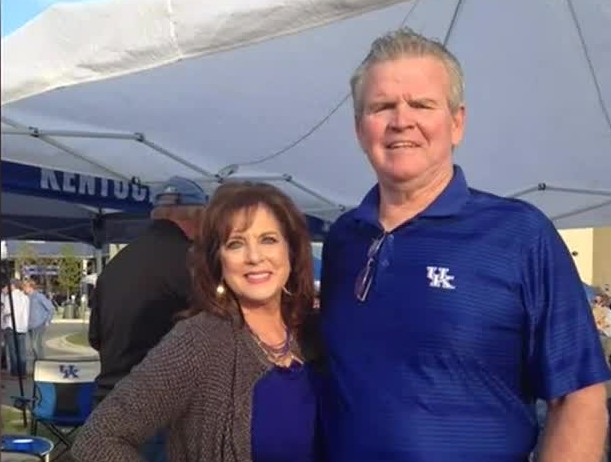
MORRISS DIED ON TUESDAY AT THE AGE OF 71.
